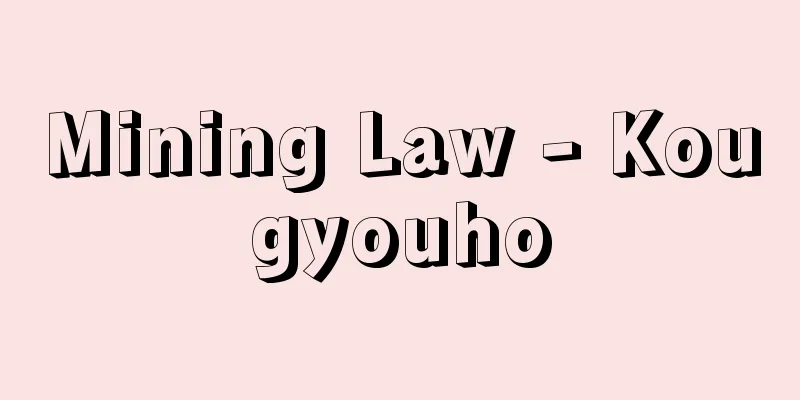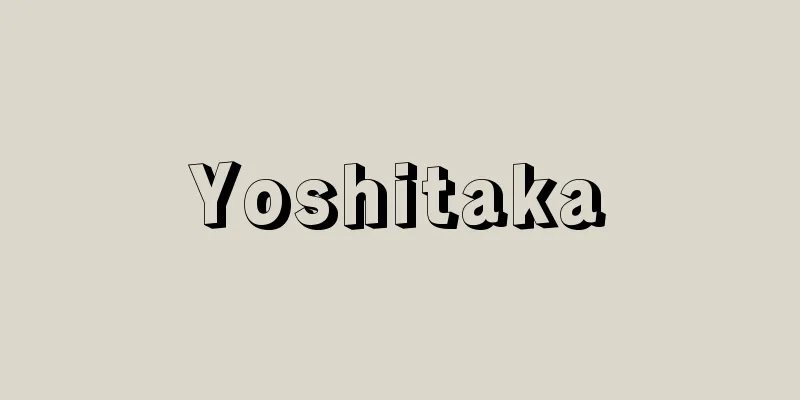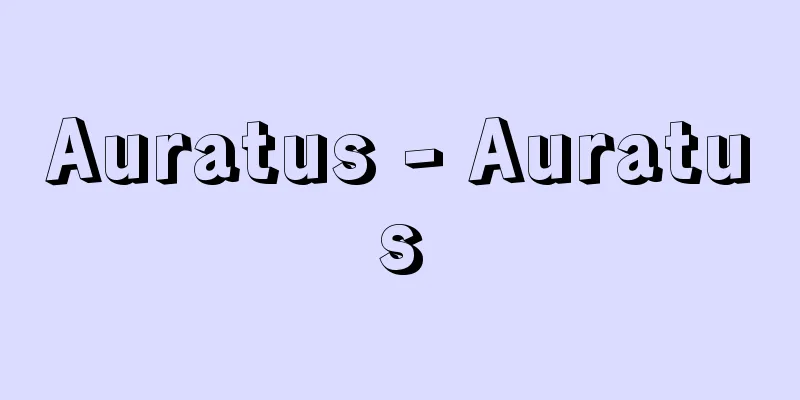Mining Law - Kougyouho

|
This law, No. 289 of 1950, established the basic system for mining in order to contribute to the promotion of public welfare by rationally developing mineral resources. The development of Japan's mining laws after the Meiji era began with Administrative Proclamation No. 177 of 1869 (Meiji 2), followed by Dajokan Proclamation No. 173 of 1871, Dajokan Proclamation No. 100 of 1872, "Mining Guidelines," and finally Dajokan Proclamation No. 259 of 1873, "Japan Mining Law," which finally established the form of law. These laws and regulations stipulated that all mineral products would become the property of the government, and that the government would monopolize the development rights, and were based on the idea of state monopoly of mines. Later, with the rise of the capitalist economy, there was a growing trend to promote the liberalization and rational development of the mining industry, and the Mining Ordinance of 1890 (Meiji 23) allowed equal freedom in mining management under certain conditions, which was established as the basic principle of the Mining Law. The so-called old Mining Law of 1905 was a compilation of laws related to mining, and regulated Japan's mining industry for about 50 years, undergoing 18 amendments. Among the amendments was the addition of a chapter on mining compensation, which was epoch-making in that it recognized liability for compensation without fault. The current Mining Law was enacted to replace the old Mining Law in order to respond to the changes in the legal system and social and economic development after World War II. The current Mining Act consists of 10 chapters and 194 articles. Chapter 1, "General Provisions," provides basic matters such as the purpose of this Act, the state's function of granting mining rights, the prohibition of mining of unexcavated minerals without a mining right, and the definitions of mining, mining rights, and mining lease rights. Chapter 2, "Mining Rights," provides that mining rights are divided into two types: prospecting rights and mining rights, and their legal characteristics, that holders of mining rights must be Japanese nationals or Japanese corporations, that permission must be obtained from the Director-General of the Ministry of International Trade and Industry to establish mining rights, and that the person who applied earlier has priority for permission. It also provides for matters such as application procedures and examination standards for establishing mining rights, changes to applications, changes and extinction of mining rights, and registration of mining rights. It also stipulates restrictions on the area of mining areas and public interest, and the duration of prospecting rights. Chapter 3, "Mining Lease Rights," provides for the nature of mining lease rights, boundaries of mining lease areas, establishment and duration of mining lease rights, application procedures, and changes, extinction, and cancellation of mining lease rights. Chapter 4, "Recommendations and Consultations," provides that, when necessary, the Director-General of the International Trade and Industry Bureau may recommend to the mining right holder the exchange or sale of mining rights, the increase or decrease of mining areas, and changes to the operation plan, and provides for the procedures and effectiveness of such recommendations. Chapter 5, "Use and Expropriation of Land," provides that those who wish to carry out mining activities may enter, use, and expropriate other people's land for surveying or field investigations, and provides for the procedures for such actions. Chapter 6, "Compensation for Mining," provides that, when damage is caused to other people by the mining of minerals, the mining right holder or mining lease holder at the time of the occurrence of the damage shall be liable for compensation without fault, and provides for the standards and scope of such liabilities, the deposit of security, and mediation for settlement. Chapter 6-2, "Local Mining Councils," provides for the establishment, organization, and operation of local mining councils that investigate and deliberate on compensation for losses due to dispositions such as the cancellation of mining rights, the amount of contributions, and the appropriate standards for mining compensation. Chapter 7, "Appeals," provides for the right to appeal against administrative dispositions by the Director-General of the Ministry of International Trade and Industry regarding mining, and the procedures for doing so. Chapter 8, "Supplementary Provisions," provides for the limits on fees for applications for mining rights, and the public notice and posting of administrative dispositions by the Director-General of the Ministry of International Trade and Industry. Chapter 9, "Penalties," provides for penalties for violations of this law, such as theft and trespass. In addition, the supplementary laws to this law include the Mining Law Enforcement Law, Mining Law Enforcement Regulations, Mining Registration Order, Mining Law-related Fee Order, and Mine Damage Compensation Registration Order, and related laws include the Quarrying Law, Mine Safety Law, Pollution Adjustment Committee Establishment Law, and Petroleum Industry Law. [Saburo Miyata] "Mining Law by Sakae Wagatsuma and Sho Toyoshima, reprint (Complete Collection of Legal Studies 51, 1990, Yuhikaku)" [Reference] |Source: Shogakukan Encyclopedia Nipponica About Encyclopedia Nipponica Information | Legend |
|
鉱物資源を合理的に開発することによって公共の福祉の増進に寄与するため、鉱業に関する基本的制度を定めた法律。昭和25年法律第289号。明治以後の、わが国の鉱業法の発展は、1869年(明治2)の行政官布告第177号に始まり、71年の太政官(だじょうかん)布告第173号、72年の太政官布告第100号「鉱山心得」を経て、73年の太政官布告第259号「日本坑法」において初めて法律としての体裁が整えられた。これらの諸法令は、鉱産物はすべて政府の所有に帰し、その開発権も政府が独占することを定めて、鉱山の国家専有主義の考え方を基礎とするものであった。その後、資本主義経済の台頭に伴い、鉱業の自由化と合理的開発を促進すべき気運が高まり、1890年(明治23)の「鉱業条例」において、一定の要件のもとに平等に鉱業経営の自由を認めることになり、これが鉱業法の基本的理念として確立された。1905年のいわゆる旧「鉱業法」は、鉱業に関する法令の集大成で、約50年間、18回の改正を経ながら日本の鉱業を規制した。改正のなかでは、鉱業賠償の章が追加され、無過失賠償責任を認めた点で、画期的な意義を有するものであった。現行の鉱業法は、第二次世界大戦後の法体系の変革および社会・経済的発展に対処するため、旧鉱業法にかわって制定されたものである。 現行鉱業法は10章194か条からなる。第1章「総則」では、本法の目的、国が鉱業権を賦与する機能を有すること、未掘採鉱物は鉱業権によるのでなければ掘採してはならないこと、鉱業・鉱業権・租鉱権の定義など、基本的事項を定める。第2章「鉱業権」では、鉱業権は試掘権と採掘権の2種とすること、およびそれらの法律上の性質、鉱業権者となりうる者は日本国民または日本国法人でなければならず、鉱業権設定のためには通商産業局長の許可を受けなければならないこと、許可は出願の日時の先の者が優先権をもつことなど、鉱業権設定のための出願手続と審査基準、出願の変更、鉱業権の変更と消滅、鉱業権の登録等の事項を定め、また、鉱区の面積と公益との調整のための制限、試掘権の存続期間を規定している。第3章「租鉱権」では、租鉱権の性質、租鉱区の境界、租鉱権の設定と存続期間、設定の申請方法、租鉱権の変更・消滅・取消等に関して定める。第4章「勧告及び協議」では、鉱物資源の合理的開発のため、必要な場合には、鉱業権の交換または売渡、鉱区の増減、施業案の変更等について通商産業局長が鉱業権者に勧告しうること、およびその手続・効力についての規定を置いている。第5章「土地の使用及び収用」では、鉱業を行おうとする者に測量または実地調査のため他人の土地への立入り、使用および収用が可能であること、およびその手続が定められている。第6章「鉱業の賠償」では、鉱物の掘採により他人に損害を与えた場合、損害発生時の鉱業権者または租鉱権者が無過失賠償責任を負うこと、およびその基準・範囲、担保の供託、和解の仲介について定める。また第6章の2「地方鉱業協議会」では、鉱業権取消等の処分による損失補償、負担金の額ならびに鉱業賠償の適正な基準に関して調査審議する地方鉱業協議会の設置・組織・運営などを定めている。第7章「不服申立て」では、鉱業に関する通商産業局長の行政処分に対して不服申立てができること、およびその手続について、第8章「補則」では、鉱業権の設定の出願などの手数料の限度、通商産業局長の行う行政処分の公示・掲示などについて定め、第9章「罰則」では、盗掘、侵掘など本法違反に対してそれぞれ罰則を定めている。なお、本法の付属法令として、鉱業法施行法、鉱業法施行規則、鉱業登録令、鉱業法関係手数料令、鉱害賠償登録令などが、また関係法律としては採石法、鉱山保安法、公害等調整委員会設置法、石油業法などがある。 [宮田三郎] 『我妻栄・豊島陞著『鉱業法』再版(『法律学全集51』1990・有斐閣)』 [参照項目] |出典 小学館 日本大百科全書(ニッポニカ)日本大百科全書(ニッポニカ)について 情報 | 凡例 |
<<: Public broadcasting - koukyouhoso (English spelling)
>>: Public sector - government sector
Recommend
Environmental Hygiene
The term "hygiene" refers to the study o...
Kosa [town] - Kosa
A town in Kamimashiki County, central Kumamoto Pre...
Pros
…A general term for mammals belonging to the subo...
Lehman Brothers Kuhn Loeb Inc.
...In the 20th century, the firm shifted its focu...
Juàzeiro (English spelling)
A city in the north of Bahia state on the central ...
Hachiryu [town] - Hachiryu
A former town in Yamamoto County facing the Sea of...
indicum
… [Hoshikawa Kiyochika] [Indigo as a dye] Indigo ...
Airplane - Aeroplane
What is an airplane? A type of aircraft, a vehicl...
Desiccator - Desiccator (English spelling)
A type of chemical laboratory equipment, a contai...
Stralenberg, Filipp Ijhan
[Birth] 1676 [Died] 1746 Swedish Siberianist and O...
Rhadamanthys
...He imprisoned the monster in the Labyrinth, a ...
Feijóo (English spelling) Benito Jerónimo Feijóo
1676‐1764 Spanish Benedictine monk. One of the mos...
Oriolus chinensis (English spelling) Orioluschinensis
...The birds of this genus also live in the treet...
Nusubitohagi - thief and hagi
A perennial plant of the legume family (APG class...
alto rilievo (English spelling) altorilievo
Strictly speaking, it is distinguished from simpl...









